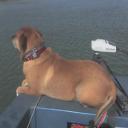Yahoo Answers is shutting down on May 4th, 2021 (Eastern Time) and beginning April 20th, 2021 (Eastern Time) the Yahoo Answers website will be in read-only mode. There will be no changes to other Yahoo properties or services, or your Yahoo account. You can find more information about the Yahoo Answers shutdown and how to download your data on this help page.
Trending News
How do fishfinders compensate for the motion of the boat?
So we were watching the BBC's Three Men in a Boat, when they showed a fishing boat fitted with a fishfinder sonar. And the question arose how the screen shows a steady picture when the boat is pitching and rolling around?
I had a quick look around the Garmin website, after a search engine failed to throw up any obvious answer, but all to no avail.
9 Answers
- ricsudukaiLv 61 decade agoFavorite Answer
The normal beam is reasonably wide, like a floodlight. The narrow focused beam is much more sensitive to this issue, but able to penetrate far deeper and sends back much stronger reflections. The transducer is quite sensitive, and will accept signal back from surprising angles. An industry level sonar such as Furuno shows reflections and bounce as ghost lines below the main image (zoom out and you will see them) and this is useful in showing bottom hardness and inversion layers etc. As a professional Fisherman I was totally uninterested in an average view - I want all the info, now, every second or quicker. I push top end Furuno and Simrad to their max, and still want more.
Unless you are in quite shallow water the rise and fall of the boat is not too apparent. Going up and down on a the swell a couple of metres at a time shows up clearly as a regular 'sine wave' bottom shape. Radical rocking due to the rapidity of movement tends to show up as breaks in the signal, with a sort of scalloped appearance - but it does have a lot to do with the settings - I have my scroll speed set very fast but it is a tool I have used a great deal and I want instant info. Set slow there is a lot of stuff you don't see.
The transducer is generally mounted in a spot on the boat that physically moves a lot less than your head does. A lot of effort is put into putting this in the most stable spot on the hull commercially. Many recreational setups are o.k. on the edge of the transom lower edge, and you won't improve much on this if you can get it closest to the keel with out interfering with the flow of water to or from the propellor.
All units no matter how cheap have a comprehensive mounting guide, if followed you will get the best out of your machine.
You probably won't find specific info regarding this, as the manufacturers are not interested in getting into a fight over how their systems work in rough conditions with casual users - when they cannot predict how the transducer will be mounted and so on.
In the commercial market the installation technicians and sales staff are very well schooled in how their systems work and must be mounted - believe me this subject is a large part of the sales pitch, and features highly in negotiating a deal!
Edit
People like me can tell you if the bottom is sand, shell, rock, mud, a mixture of some of these - we can even in our local waters identify the type and density of any weed - I can even tell the colour of the weed. As the signal is so fast on my set up I see the change on the readout instantly as the boat rocks, so it is real time and perfectly easy to compensate for - it's live footage basically.
Source(s): Ex. Pro Fisherman. - jtexasLv 71 decade ago
My fishfinder shows a kind of rippled "washboard" bottom in choppy water.
This is as good a sonar tutorial as I've ever seen:
http://www.eaglenav.com/en/Support/Tips-and-Tutori...
Remember, only the column of pixels on the far right hand edge of the screen shows what's under you right now; everything else is just history.
General rule of thumb: a lit pixel represents an object somewhere inside a circle centered under the transducer and with a diameter equal to about 1/3 the depth (for a standard 20º cone angle). So, an object showing up at 30 feet is somewhere within 5 feet of your 'ducer -- you don't know if its ahead, astern, to port or starboard, or directly underneath.
To complicate things, your sonar can detect objects outside the cone if the sensitivity is set high enough, but 1/3 is a pretty good estimation.
- Captain BillLv 61 decade ago
Knowing that the speed of the sonar wave in the water is 4921 ft/s (1500 m/s) in seawater, 4800 ft/s (1463 m/s) in freshwater (typical values used by commercial fish finders), the distance to the object that reflected the wave can be determined.
The process can be repeated up to 40 times per second.
The transducer is normally mounted near the center line on the bottom of the hull, so even with the vessel rocking the distance to the bottom is not changing very much, maybe inches.
I have seen the display show a change on the screen with the boat rocking. The filming of the depth finder could have been done in a calmer setting for better video as well.
Source(s): http://en.wikipedia.org/wiki/Fishfinder - Loyd/Mary PLv 71 decade ago
If the water is turbulent then the sonar will show a choppy line at the top of the scale , the rest Will be as normal and depending on the waves , the depth could be high or low as much as 4-5 ft .
- How do you think about the answers? You can sign in to vote the answer.
- mactheboatLv 61 decade ago
Much as the above - plus the beam is conical 11 - 45 degree,depending on the frequency, which absorbs quite a lot of motion. A heavy swell will display as seabed ripple,especially with a high screen speed.
Garmin do not make the more technical sounders,being more interested in the leisure market - try Furuno,Koden or Simrad.
- Vasco PyjamaLv 61 decade ago
The display represents an average of the depth reading over a time period. In this way, the instruments eliminates the variation that would be caused by waves or a rocking boat.
- 5 years ago
If you wish to have the ability to sleep and relax without nervousness and suffering, if you wish to enhance your mobility and mobility again you then need that guide from here https://tr.im/fE2Dl , Neuropathy Solution.
Dr. Randall Labrum, the author of the guide guarantees that the people of neuropathy can get rid of chronic nerve pain and people will get mobility back. They'll eliminate tingling and prickling feeling, get rid of numbness of the region round the influenced nerves, eliminate unexpected problems so that can finally benefit from the daily activities and all of this in only 1 month.
Return to standard living with the help of Neuropath Solution.
- ?Lv 44 years ago
this is the action. have faith me. i've got had a great boat as quickly as and it sucked. Then for the longest time i grew to become into with somebody who had a smaller boat and he grew to become into the final i've got ever had. :)






